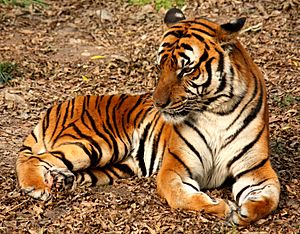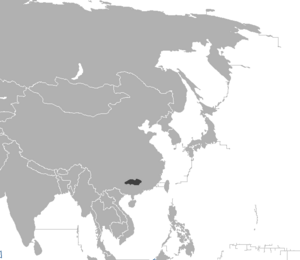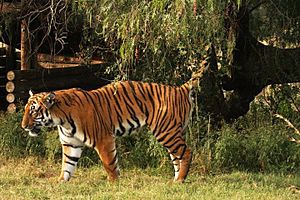South China tiger facts for kids
Quick facts for kids Panthera tigris tigris |
|
|---|---|
 |
|
| Tiger in the Shanghai Zoo | |
| Scientific classification | |
| Kingdom: | Animalia |
| Phylum: | Chordata |
| Class: | Mammalia |
| Order: | Carnivora |
| Suborder: | Feliformia |
| Family: | Felidae |
| Subfamily: | Pantherinae |
| Genus: | Panthera |
| Species: | P. tigris |
| Subspecies: | P. t. tigris |
| Trionomial name | |
| Panthera tigris tigris | |
 |
|
| Distribution of the South China tiger | |
| Synonyms | |
|
Panthera tigris subsp. amoyensis (Hilzheimer, 1905) |
|
The South China tiger is a special type of tiger found only in southern China. They used to live in provinces like Fujian, Guangdong, Hunan, and Jiangxi. This tiger is listed as Critically Endangered in China. It might even be extinct in the wild. This means no wild tigers have been seen since the late 1980s. Experts think they disappeared because there wasn't enough food. Also, their homes were destroyed and broken up.
Contents
What is a South China Tiger?
In 1905, a scientist named Max Hilzheimer gave this tiger its scientific name: Felis tigris var. amoyensis. He studied five tiger skulls from Hankou, China. These skulls looked a bit different from those of Bengal tigers.
Later studies of South China tiger skulls showed they have a unique shape. This suggests they are a very old type of tiger. Scientists believe that southern China was where tigers first spread out across Asia.
In 2017, scientists grouped all mainland Asian tigers together. But a study in 2018 found that the South China tiger is truly different. This supports the idea that there are six distinct types of tigers.
How to Recognize a South China Tiger
In 1905, Hilzheimer said the South China tiger is as tall as a Bengal tiger. But its skull and fur are different. Its teeth are shorter than those of Bengal tigers. Its head is also shorter, with eyes set closer together.
Their fur is lighter and more yellowish. Their paws, face, and belly look whiter. Their stripes are thinner, more numerous, and have sharper edges.
The South China tiger is the smallest tiger in mainland Asia. But it is bigger than the Sumatran tiger. Male tigers are about 230 to 265 centimeters (7.5 to 8.7 feet) long. They weigh 130 to 175 kilograms (287 to 386 pounds). Females are smaller. They are about 220 to 240 centimeters (7.2 to 7.9 feet) long. They weigh 100 to 115 kilograms (220 to 254 pounds). Their tail is usually less than half their body length.
Around 1910, people reported seeing a rare blue or "Maltese" tiger. This was near Fuzhou in Fujian Province.
Where South China Tigers Lived
The South China tiger used to live in a huge area of China. This area stretched about 2,000 kilometers (1,240 miles) from east to west. It was also about 1,500 kilometers (930 miles) from north to south. They lived from Jiangxi and Zhejiang provinces in the east. Their range went west through Guizhou and Sichuan provinces. In the north, they reached the Qinling Mountains. In the south, they lived in Guangdong, Guangxi, and Yunnan provinces.
South China tigers were likely connected to Siberian tigers. They used to move through the Yellow River basin. But humans later stopped this connection.
Why the Population Declined
In the early 1950s, there were over 4,000 South China tigers in the wild. But then, the government started a big hunting campaign. This was part of Mao Zedong's Great Leap Forward. Hunting, along with cutting down forests, hurt the tigers. There was also less prey for them to eat. Many people moved from cities to the countryside. This broke up tiger groups. By 1982, only about 150 to 200 South China tigers were left.
By 1987, there were only an estimated 30 to 40 tigers left. This meant they were very close to extinction. In 1990, signs of tigers were found in 11 mountain areas. But no tigers were actually seen. Only tracks, scratch marks, and local reports were found.
In 2001, scientists used camera traps and GPS. They searched 2,214 square kilometers (855 square miles) in five provinces. But they found no proof of tigers. No tiger droppings were confirmed. They did find signs of animals that tigers might eat.
Around 2000, some people still thought wild South China tigers might exist. Local people reported tracks and sightings. In 2007, China's government said there was no confirmed presence of these tigers. They announced a goal to bring them back to the wild.
Tiger Behavior and Life Cycle
Tigers are carnivores, meaning they only eat meat. They like to hunt large animals with hooves. They often kill wild boar. Sometimes they hunt hog deer, muntjac, and gray langur monkeys. Smaller animals like porcupines and hares are a very small part of their diet. If humans live nearby, tigers might hunt farm animals.
Tigers usually sneak up on their prey from the side or behind. They get as close as possible. Then they grab the prey's throat to kill it. After that, they drag the animal to a hidden spot to eat. They can drag it for hundreds of meters. Tigers eat a lot at once, usually 18 to 40 kilograms (40 to 88 pounds) of meat. This is because they don't always find food easily.
Tigers can mate any time of year. But they usually breed from late November to early April. Males are ready to mate at 5 years old. Females are ready at 4 years old. Baby tigers are born about 103 days after mating. A mother tiger usually has three to six cubs in a den.
Cubs are born blind. They weigh between 780 and 1,600 grams (1.7 to 3.5 pounds). They drink their mother's milk for at least 8 weeks. Their mother teaches them to hunt when they are 6 months old. When they are 18 to 24 months old, the young tigers leave their mother.
In the past, tiger attacks on people increased in China. This happened during the Ming and Qing dynasties. More people meant they moved into tiger homes. About 500 attacks happened then. These attacks often led to deaths. In 1957, a tiger reportedly attacked and killed 32 people in Hunan province.
Protecting South China Tigers
In 1973, the South China tiger was listed as "protected by controlled hunting." In 1977, all hunting was stopped. All types of tigers are now protected by CITES. This means international trade of tigers is banned. Many countries have also stopped local trade. In 2007, there was a call to end tiger farming in China.
The South China tiger is listed as critically endangered in China.
The group Save China's Tigers is working to help. They want to bring captive-born South China tigers back to the wild. They plan to use large fenced areas in southern China. The main challenges are finding good homes and enough prey. Also, the captive tigers need to be able to survive in the wild. They need to recover wild animal populations for the tigers to eat. The goal is to have at least three groups of tigers. Each group would have 15 to 20 tigers. They would live in at least 1,000 square kilometers (386 square miles) of natural land.
Tigers in Zoos
In 1986, 17 Chinese zoos had 40 pure South China tigers. None of them were born in the wild. All were descendants of one wild tigress and five other tigers. There were problems like too many males or females. Also, tigers were not paired well for breeding. By 2005, there were 57 captive tigers. They showed signs of inbreeding, meaning they were too closely related. This led to less healthy offspring.
In 2007, there were 72 captive tigers worldwide. Few were outside China. Many were not "pure" South China tigers. They had been mixed with other types of tigers. In 2019, about 150 South China tigers were in captivity in China. Most were part of a breeding program.
A cub was born in a private reserve in South Africa in 2007. This was the first one born outside China. Since then, more cubs have been born there. By 2016, the Laohu Valley Reserve had 19 tigers.
China keeps a central record of all captive South China tigers. This helps manage their breeding. Before this record, people thought there weren't enough pure tigers to save the species. But more tigers have been found in zoos across China.
Rewilding Tigers
What is Rewilding?
The word "rewilding" was created in 2003. It was used to describe the Save China's Tigers project. This project aims to help tigers learn to live in the wild again. Now, many wildlife groups use this term.
Rewilding Project in South Africa

The Save China's Tigers group made an agreement in 2002. They worked with China's government and a South African trust. The plan is to create a tiger conservation model. They will build a special reserve in China. Wild animals, including the South China tiger, will be brought back there.
Save China's Tigers wants to help these endangered tigers. They bring captive-bred tigers to a private reserve in South Africa. Here, the tigers learn how to hunt again. They regain their wild instincts. At the same time, a pilot reserve is being set up in China. Once it's ready, the cubs born in South Africa will be released there. The adult tigers will stay in South Africa to keep breeding.
South Africa was chosen because it has experts, land, and prey for the tigers. The tigers in the project have learned to hunt successfully. They can now survive on their own. This project has also been good for breeding. Fourteen cubs have been born, and 11 survived. These second-generation cubs can learn survival skills directly from their mothers. It was hoped that these cubs could be released into the wild in 2012.
How People Reacted to the Project
Some conservation groups have concerns about the project. The WWF thinks the money could be better spent. They believe the Siberian tiger has a better chance of survival. However, other scientists agree that rewilding captive tigers is important.
In 2010, experts met in South Africa. They looked at the progress of the rewilding program. These experts included scientists from various wildlife organizations. They also included Chinese government scientists.
The tigers in the project were born in zoos. Their parents also lived in cages. This means they couldn't hunt or live naturally. The cubs were sent to South Africa to learn these skills. The workshop confirmed that the South China Tiger Rewilding Project is important. Dr. David Smith said, "Having seen the tigers hunting in an open environment... I believe that these rewilded tigers have the skill to hunt in any environment." The project has also helped restore natural homes for tigers in China and South Africa. It seems possible that captive-born tigers can soon be released into the wild.
Claims of Tiger Photos
In 2007, a villager in China claimed he took over 30 digital photos of a tiger. The Shaanxi Provincial Forestry Bureau supported his claim.
But many people doubted the photos were real. In November 2007, the Bureau still believed wild South China tigers existed. However, in February 2008, they apologized. They said they released the news too quickly. They admitted they didn't have strong proof.
In June 2008, authorities announced that the photos were fake. The people involved were punished. The photographer was arrested for fraud. This ended the scandal.
See also
 In Spanish: Tigre de Amoy para niños
In Spanish: Tigre de Amoy para niños
-
- Prehistoric tigers: Panthera tigris soloensis
- Panthera tigris trinilensis
- Panthera tigris acutidens
- Holocene extinction



